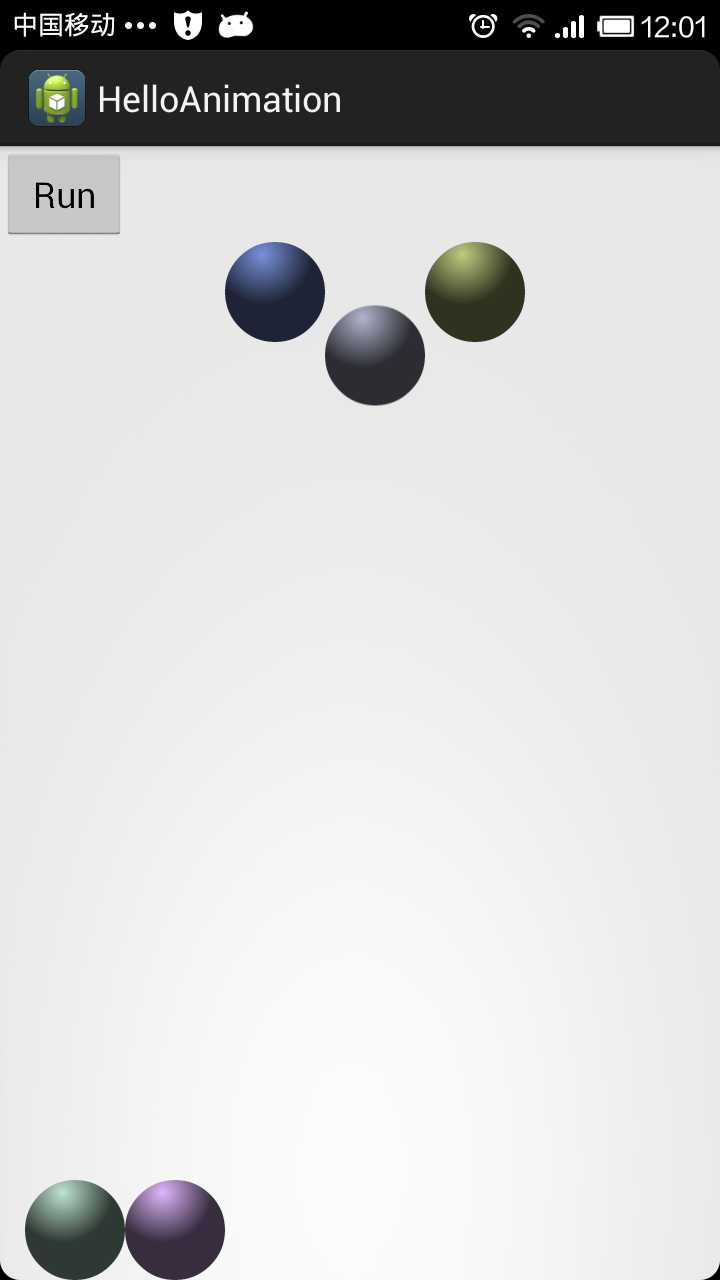标签:
Animator类提供了创建动画的基本结构,但是一般使用的是它的子类:
ValueAnimator、ObjectAnimator、AnimatorSet
ApiDemos中Animation部分是单独的一个包。
下面代码来自ApiDemos中的AnimationCloning类,加了一个使用ValueAnimator的动画,还有一些注释。
完整的项目见:URL:https://github.com/mengdd/AnimationApiDemos.git
package com.example.helloanimation.demo1;
import java.util.ArrayList;
import com.example.helloanimation.R;
import com.example.helloanimation.demo.ShapeHolder;
import android.animation.AnimatorSet;
import android.animation.ObjectAnimator;
import android.animation.ValueAnimator;
import android.animation.ValueAnimator.AnimatorUpdateListener;
import android.app.Activity;
import android.content.Context;
import android.graphics.Canvas;
import android.graphics.Paint;
import android.graphics.RadialGradient;
import android.graphics.Shader;
import android.graphics.drawable.ShapeDrawable;
import android.graphics.drawable.shapes.OvalShape;
import android.os.Bundle;
import android.view.View;
import android.view.animation.AccelerateInterpolator;
import android.view.animation.DecelerateInterpolator;
import android.widget.Button;
import android.widget.LinearLayout;
public class BasicAnimationActivity extends Activity {
@Override
protected void onCreate(Bundle savedInstanceState) {
super.onCreate(savedInstanceState);
// 设置布局,布局xml中只包含了一个线性布局和一个Button
setContentView(R.layout.animation_basic);
LinearLayout container = (LinearLayout) findViewById(R.id.container);
// 将自定义的View加入到线性布局中
final MyAnimationView animView = new MyAnimationView(this);
container.addView(animView);
// Button的点击事件即动画开始
Button starter = (Button) findViewById(R.id.startButton);
starter.setOnClickListener(new View.OnClickListener() {
public void onClick(View v) {
animView.startAnimation();
}
});
}
/**
* 自定义的View类
* 其中包含了一系列的球形对象
*
*/
public class MyAnimationView extends View implements
ValueAnimator.AnimatorUpdateListener {
// 圆形球
public final ArrayList<ShapeHolder> balls = new ArrayList<ShapeHolder>();
// 总的动画集合
AnimatorSet animation = null;
// 屏幕密度
private float mDensity;
public MyAnimationView(Context context) {
super(context);
// 得到密度值
mDensity = getContext().getResources().getDisplayMetrics().density;
addBall(50f, 25f);
addBall(150f, 25f);
addBall(250f, 25f);
addBall(350f, 25f);
addBall(450f, 25f);
}
private void createAnimation() {
if (animation == null) {
// ===============================================
// 第1个球球的动画效果:用ObjectAnimator
// 用工厂方法构造对象:用ofFloat()因为属性值是float类型
// 第1个参数为目标对象:balls.get(0)
// 第2个参数为属性名:y 这里要求目标对象要有“set属性名()”的方法。
// 后面是可变参数,表明属性目标值,一个参数表明是终止值(对象要有get属性方法)
// 可变参数的个数为2时,表明第一个是起始值,第二个是终止值;更多个参数时,动画属性值会逐个经过这些值
ObjectAnimator anim1 = ObjectAnimator.ofFloat(balls.get(0),
"y", 0f, getHeight() - balls.get(0).getHeight())
.setDuration(500);
// ===============================================
// 第二个球球的动画效果:clone动画效果1,但是重新设置目标物体
ObjectAnimator anim2 = anim1.clone();
anim2.setTarget(balls.get(1));
anim1.addUpdateListener(this);
// 因为前两个动画完全相同,所以设置刷新监听的时候就只设置了一个(它们刷新的是同一个View)
// ===============================================
// 第三个球球的动画效果:先加速下落,再减速上升
ShapeHolder ball2 = balls.get(2);
// 动画效果:落下效果
ObjectAnimator animDown = ObjectAnimator.ofFloat(ball2, "y",
0f, getHeight() - ball2.getHeight()).setDuration(500);
// 落下效果改变了Interpolator,设置为加速
animDown.setInterpolator(new AccelerateInterpolator());
// 动画效果:上升效果
ObjectAnimator animUp = ObjectAnimator.ofFloat(ball2, "y",
getHeight() - ball2.getHeight(), 0f).setDuration(500);
// 上升效果设置为减速上升
animUp.setInterpolator(new DecelerateInterpolator());
// 用一个AnimatorSet对象将下落效果和上升效果顺序播放
AnimatorSet s1 = new AnimatorSet();
s1.playSequentially(animDown, animUp);// 顺序播放效果,参数个数可变
// 下落动画刷新View
animDown.addUpdateListener(this);
// 上升动画刷新View
animUp.addUpdateListener(this);
// ===============================================
// 第四个球球的动画效果
// 另一个AnimatorSet克隆了上一个set,更换了对象
AnimatorSet s2 = (AnimatorSet) s1.clone();
s2.setTarget(balls.get(3));
// ===============================================
// 第五个球球的动画效果:使用ValueAnimator
final ShapeHolder ball5 = balls.get(4);
ValueAnimator valueAnimator5 = ValueAnimator.ofFloat(0f,
getHeight() - ball5.getHeight());
valueAnimator5.setDuration(500);
valueAnimator5.addUpdateListener(new AnimatorUpdateListener() {
// ValueAnimator需要自己在监听处理中设置对象参数
@Override
public void onAnimationUpdate(ValueAnimator animation) {
// 用animation.getAnimatedValue()得到当前的属性值,设置进动画对象中
ball5.setY((Float) animation.getAnimatedValue());
// 记得要刷新View否则不会调用重新绘制
invalidate();
}
});
// =============================================================
// 用一个总的AnimatorSet对象管理以上所有动画
animation = new AnimatorSet();
animation.playTogether(anim1, anim2, s1);// 并行
animation.playSequentially(s1, s2, valueAnimator5);// 串行
}
}
// 在指定位置加上球形
private ShapeHolder addBall(float x, float y) {
OvalShape circle = new OvalShape();
circle.resize(50f * mDensity, 50f * mDensity);
ShapeDrawable drawable = new ShapeDrawable(circle);
ShapeHolder shapeHolder = new ShapeHolder(drawable);
shapeHolder.setX(x - 25f);
shapeHolder.setY(y - 25f);
int red = (int) (100 + Math.random() * 155);
int green = (int) (100 + Math.random() * 155);
int blue = (int) (100 + Math.random() * 155);
int color = 0xff000000 | red << 16 | green << 8 | blue;
Paint paint = drawable.getPaint(); // new
// Paint(Paint.ANTI_ALIAS_FLAG);
int darkColor = 0xff000000 | red / 4 << 16 | green / 4 << 8 | blue
/ 4;
RadialGradient gradient = new RadialGradient(37.5f, 12.5f, 50f,
color, darkColor, Shader.TileMode.CLAMP);
paint.setShader(gradient);
shapeHolder.setPaint(paint);
balls.add(shapeHolder);
return shapeHolder;
}
@Override
protected void onDraw(Canvas canvas) {
// 遍历并绘制每一个球形对象
for (int i = 0; i < balls.size(); ++i) {
ShapeHolder shapeHolder = balls.get(i);
canvas.save();
canvas.translate(shapeHolder.getX(), shapeHolder.getY());
shapeHolder.getShape().draw(canvas);
canvas.restore();
}
}
public void startAnimation() {
createAnimation();
animation.start();// 这里开始播放动画
}
@Override
public void onAnimationUpdate(ValueAnimator animation) {
// 在参数更新的时候invalidate,刷新整个View的绘制
// 否则onDraw不会被调用,即看不到View外观的改变
invalidate();
}
}
}
其中ShapeHolder:

package com.example.helloanimation.demo;
import android.graphics.Paint;
import android.graphics.RadialGradient;
import android.graphics.drawable.ShapeDrawable;
import android.graphics.drawable.shapes.Shape;
import android.view.View;
/**
*
* A data structure that holds a Shape and various properties that can be used to define
* how the shape is drawn.
* (从API Demos中直接搬过来的类)
*
*/
public class ShapeHolder {
private float x = 0, y = 0;
private ShapeDrawable shape;
private int color;
private RadialGradient gradient;
private float alpha = 1f;
private Paint paint;
public void setPaint(Paint value) {
paint = value;
}
public Paint getPaint() {
return paint;
}
public void setX(float value) {
x = value;
}
public float getX() {
return x;
}
public void setY(float value) {
y = value;
}
public float getY() {
return y;
}
public void setShape(ShapeDrawable value) {
shape = value;
}
public ShapeDrawable getShape() {
return shape;
}
public int getColor() {
return color;
}
public void setColor(int value) {
shape.getPaint().setColor(value);
color = value;
}
public void setGradient(RadialGradient value) {
gradient = value;
}
public RadialGradient getGradient() {
return gradient;
}
public void setAlpha(float alpha) {
this.alpha = alpha;
shape.setAlpha((int)((alpha * 255f) + .5f));
}
public float getWidth() {
return shape.getShape().getWidth();
}
public void setWidth(float width) {
Shape s = shape.getShape();
s.resize(width, s.getHeight());
}
public float getHeight() {
return shape.getShape().getHeight();
}
public void setHeight(float height) {
Shape s = shape.getShape();
s.resize(s.getWidth(), height);
}
public ShapeHolder(ShapeDrawable s) {
shape = s;
}
}
效果如图:


ValueAnimator使用时可以需要自己设置监听,将变动的值设置给目标对象:
ValueAnimator构造使用工厂方法。
上面例子中相应的代码片段:
// ===============================================
// 第五个球球的动画效果:使用ValueAnimator
final ShapeHolder ball5 = balls.get(4);
ValueAnimator valueAnimator5 = ValueAnimator.ofFloat(0f,
getHeight() - ball5.getHeight());
valueAnimator5.setDuration(500);
valueAnimator5.addUpdateListener(new AnimatorUpdateListener() {
// ValueAnimator需要自己在监听处理中设置对象参数
@Override
public void onAnimationUpdate(ValueAnimator animation) {
// 用animation.getAnimatedValue()得到当前的属性值,设置进动画对象中
ball5.setY((Float) animation.getAnimatedValue());
// 记得要刷新View否则不会调用重新绘制
invalidate();
}
});
ObjectAnimator是ValueAnimator的子类,构造时也用工厂方法。
ObjectAnimator不用自己设置监听来设置对象的值,要动画的对象和要改变的属性都在构造的时候设置好了。
比如前两个球球的动画:
// ===============================================
// 第1个球球的动画效果:用ObjectAnimator
// 用工厂方法构造对象:用ofFloat()因为属性值是float类型
// 第1个参数为目标对象:balls.get(0)
// 第2个参数为属性名:y 这里要求目标对象要有“set属性名()”的方法。
// 后面是可变参数,表明属性目标值,一个参数表明是终止值(对象要有get属性方法)
// 可变参数的个数为2时,表明第一个是起始值,第二个是终止值;更多个参数时,动画属性值会逐个经过这些值
ObjectAnimator anim1 = ObjectAnimator.ofFloat(balls.get(0),
"y", 0f, getHeight() - balls.get(0).getHeight())
.setDuration(500);
// ===============================================
// 第二个球球的动画效果:clone动画效果1,但是重新设置目标物体
ObjectAnimator anim2 = anim1.clone();
anim2.setTarget(balls.get(1));
anim1.addUpdateListener(this);
// 因为前两个动画完全相同,所以设置刷新监听的时候就只设置了一个(它们刷新的是同一个View)
AnimatorSet用来组织动画,动画可以同时播放,顺序播放,也可以设定一定的延迟之后播放。
playTogether()表示动画同时播放。
playSequentially() 表示动画顺序播放。
比如第三个球球先加速下降再减速上升的动画:
// ===============================================
// 第三个球球的动画效果:先加速下落,再减速上升
ShapeHolder ball2 = balls.get(2);
// 动画效果:落下效果
ObjectAnimator animDown = ObjectAnimator.ofFloat(ball2, "y",
0f, getHeight() - ball2.getHeight()).setDuration(500);
// 落下效果改变了Interpolator,设置为加速
animDown.setInterpolator(new AccelerateInterpolator());
// 动画效果:上升效果
ObjectAnimator animUp = ObjectAnimator.ofFloat(ball2, "y",
getHeight() - ball2.getHeight(), 0f).setDuration(500);
// 上升效果设置为减速上升
animUp.setInterpolator(new DecelerateInterpolator());
// 用一个AnimatorSet对象将下落效果和上升效果顺序播放
AnimatorSet s1 = new AnimatorSet();
s1.playSequentially(animDown, animUp);// 顺序播放效果,参数个数可变
// 下落动画刷新View
animDown.addUpdateListener(this);
// 上升动画刷新View
animUp.addUpdateListener(this);
因为参数是Animator类型的对象集合或者可变参数,所以表示AnimationSet是可嵌套使用的,因为AnimationSet是Animator的子类。
// =============================================================
// 用一个总的AnimatorSet对象管理以上所有动画
animation = new AnimatorSet();
animation.playTogether(anim1, anim2, s1);// 并行
animation.playSequentially(s1, s2, valueAnimator5);// 串行
Demo中就是将所有的动画都放在一个AnimationSet对象中,最后调用start()方法播放。
API Guides:Property Animation
http://developer.android.com/guide/topics/graphics/prop-animation.html#value-animator
博文:
http://www.cnblogs.com/angeldevil/archive/2011/12/02/2271096.html
项目地址:
https://github.com/mengdd/AnimationApiDemos.git
posted on 2013-09-05 14:03 圣骑士wind 阅读(3453) 评论(1) 编辑 收藏
Android Animation学习(二) ApiDemos解析:基本Animatiors使用
标签:
原文地址:http://www.cnblogs.com/Free-Thinker/p/4384193.html
评论
#1楼 回复引用